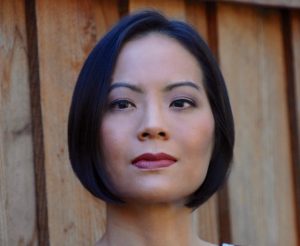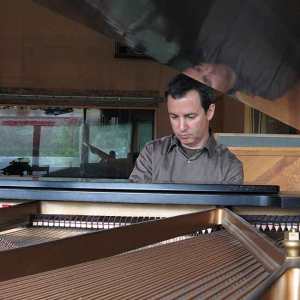It was a pleasant spring day in San Jose where, in this modest hall, there was to be a concert of mostly contemporary music with one exception. The concert was billed as “A Touch of Tech” due to its use in some pieces of electronics and, in one case, slide projections. However the overall sense of the experience left this writer with a strong sense of the romantic, hence the title of this review.The Concert Hall at the Le Petit Trianon Theater in San Jose
The concert was to be led by the San Jose Chamber Orchestra‘s music director and regular conductor Barbara Day Turner. A quick look at the orchestra’s web site or the repertoire of tonight’s conductor will dazzle and intrigue any fan of new music. This modest ensemble of approximately 20 musicians (give or take) consists of professional musicians who clearly take their work seriously. No spoilers here in saying that they turned in some seriously powerful and polished performances.Conductor Barbara Day Turner (from the SJCO web site)
This writer was initially asked to review this performance on behalf of the management agents of composer Vivian Fung (1975- ), a Canadian-American composer whose star is rising rapidly. In preparation for the evening’s performance it was wonderful to find some of her work on You Tube. It was a rewarding experience to hear some of her range of compositions. The featured composition of hers for this evening was Humanoid (2017) for cello and electronics. It was third in the programming sequence for the evening.
First up though was a composition which initially seemed anachronistic in context. It was Dvorak’s Silent Woods (1833) for cello and orchestra in a transcription for cello and strings by Kerry Lewis. This piece of unabashed high romanticism in fact seemed to contextualize what was to follow. The soloist Coleman Itzkoff gave a wonderful display of his romantic chops in his interpretation of this somewhat lesser known bon bon of Dvorak’s. The audience responded most appreciatively to a lush and lovely performance.Vivian Fung (from her web site)
Second up was Green (2008-16) by Scottish-American composer Thea Musgrave (1928- ). This work was being played in honor of her 90th year. Mr. Musgrave was reportedly unable attend this evening, not due to infirmity but rather to industry. She is reportedly hard at work adding to her already prolific catalog of works. (This version was a string orchestra version prepared by Martyn Brabbins.) Nonetheless her presence was strongly felt in this recent ecologically themed piece for string orchestra (sans electronics). The tonalities in the work seemed to almost be echoes from the first work. Despite a few string effects, pizzicati, glissandi, there was an overall feeling of romantic gestures here in a discursive development that included a disturbing motif from the double basses and rather romantic and lyrical responses from solo violin and viola embedded in the lush orchestral textures (it is astonishing to hear what a master composer can do with a small string orchestra). The conductor and ensemble displayed an intensity of concentration which resulted in a really spectacular performance which was very much appreciated by the audience. (Curious side note: I later learned that an elderly gentleman who sat in front of me and listened with obvious concentration and appreciation throughout the program was in fact a relative of Ms. Musgrave so, at least by that proxy she was there in yet another capacity.)Thea Musgrave (from her website)
The stage was then set for the west coast premiere of Vivian Fung’s Humanoid for cello and electronics. Here I had the advantage of being able to speak with the evening’s engineer (and electronic co-conspirator) Tom Johnson. This gentleman advised me of his roles in the three pieces which involved technology. Apparently the Fung piece required the most attention and coordination involving a click track. The Shatin piece basically played the electronics in parallel to the orchestra with the coordination largely left (presumably) to the conductor. And the last piece involved projections whose synchronization were not as minutely critical as the other two pieces. Said gentleman was also the recording engineer for this concert.Coleman Itzkoff playing Vivian Fung’s Humanoid
For this writer the term “electroacoustic” indicates that one should approach such a work with caution. Indeed the success of the integration of electronics and acoustic instruments varies a great deal. Perhaps the best known of such efforts are the pioneering “Synchronisms” of Mario Davidovsky in which various instruments are paired with an electronic track. And these days one must ask if the electronics interacts with or alters the sound of the acoustic instrument or if it exists in parallel. Electroacoustic music has been and remains a huge compositional challenge and no small challenge for the listener.
In the case of Fung’s piece the electronics exist in parallel but carefully synchronized (the soloist does listen to a click track) to the cello score. No alteration of the cello’s sound is done by anyone other than the cellist. So we are then hearing basically a duo between two musical streams, one live, the other on a digital stream of largely concrete sounds and, at one point, a drum kit. Such technical issues can be tiring but the sound of the music was not. According to the composer the piece is in three parts. The cello and the electronics are both equally present in all. In fact the cello seems to be creating sounds that are analogous to the electronic sounds at times and the cellist is given a lot of large romantic sounding gestures which in many ways were not entirely different emotionally than the gestures of the Dvorak. Fung’s work seems, appropriately here in Silicon Valley, to be challenging the human vs. the machine, an increasingly intriguing dichotomy.
It was clearly a challenging piece for the cellist requiring a plethora of techniques and a great deal of virtuosity. Itzkoff handled his role with stern concentration and demonstrated a strong command of both his instrument and the score. He was rewarded with a standing ovation and two curtain calls for his efforts which he gratefully accepted. The program notes indicated that this was Fung’s first major foray into the use of electronics and one hopes not the last.
Following intermission was the premiere performance of the work of another established citizen of American music. It was Judith Shatin‘s Ice Becomes Water (2018) commissioned by Barbara Day Turner and the San Jose Chamber Orchestra and is dedicated to them. Shatin is a sound artist as well as a composer meaning that she has mastered the incorporation of a variety of sounds into her compositional palette. In this case she utilized sound samples gathered by glaciologist Oscar Glowacki.Judith Shatin (from her web site)
This piece continued the basically pastoral/ecological themes suggested by the earlier works. Again too there was lyricism though the sound images here were, appropriately, colder and more stark than those in some of the other compositions. In fact this composition seemed to have some affinities to the sound world of Musgrave’s work at times but perhaps a bit harsher. What sustained interest here, in addition to the sonic inventiveness of the string writing, was the seamless integration of the sounds into the overall texture. Here the electronics seemed to augment Penderecki like sound mass effects and gave way to gentler clicking sounds (or were they pizzicati?). It was another very intense but very satisfying musical experience for this writer and, by the sound of the applause, the rest of the audience as well. Happily Shatin was there to enjoy the success of this performance and the appreciation of her artistry.
To end the program there was a multimedia work by William Susman (1960- ) The work of this composer is new to this reviewer’s ears but not apparently to the music world at large. A quick perusal of Susman’s web page reveals a prolific composer who maintains a busy schedule of composing and performing (including a performance of his recent opera, Fordlandia at the Forth Worth Opera Frontiers Showcase) coming up in May.William Susman (photo from his website)
The work was a piece entitled, In a State of Patterns (2018) which received its premiere on this night. The work is a series of six movements which are designed to respond (or maybe create musical analogs) to 6 art works created by Santa Clara University mathematician Frank Farris (1955- ).
The movements (performed without pause) are: 1. California, the Golden State, 2. The Sierra Nevada, 3. At Home in San Jose, 4. Sierra Tree Death, 5. Spiral Vortex, and 6. The Stars Come Out to Comfort Us.Frank Farris (from the Santa Clara website)
The photos and mathematical abstractions were projected stage left and more or less synced to the music. This writer is not well schooled in mathematics but the appearance of the images were reminiscent of those never ending fractal drawings which eternally reproduce themselves. Farris apparently extracts the images and colors from photographs. Now whether the music creates successful analogies is probably more relevant to the level of satisfaction that each of the artists feels with their work but the effect in performance was quite satisfying. One can safely say (I think) that the music and the art work both have sufficient merit to stand successfully on their own but the combination was at least intriguing.
Susman’s music draws on some very pleasant minimalist type structures that nonetheless managed to take on almost Wagnerian grandiosity at times. Again the combination of ecology and a sort of high romanticism combined to create a very successful and enjoyable work. The abrupt ending reminiscent of the ensemble performances of Philip Glass provided a stunning coda waking the audience from the beautiful dreams evoked by the six movements. Again we witnessed a powerful and dedicated premiere performance of a wonderful piece of music which appeared to leave the audience quite satisfied. Susman was there to take a much deserved bow.
This was some brilliant programming and excellent musicianship. What an evening!!!
- Comment
- Reblog
-
Subscribe
Subscribed
Already have a WordPress.com account? Log in now.








[…] Susman (1960- ) may not be a household name but, since my first encounter (purely by chance) with this man’s work I have heard, enjoyed, and reviewed several fascinating CDs of chamber […]
LikeLike
[…] first encountered this man’s music in a concert by the San Jose Chamber Orchestra (reviewed here). I subsequently reviewed his album Scatter My Ashes . Now fresh off the presses is the […]
LikeLike
[…] first encountered this man’s music in a concert by the San Jose Symphony (reviewed here). I subsequently reviewed his album Scatter My Ashes . Now fresh off the presses is the […]
LikeLike